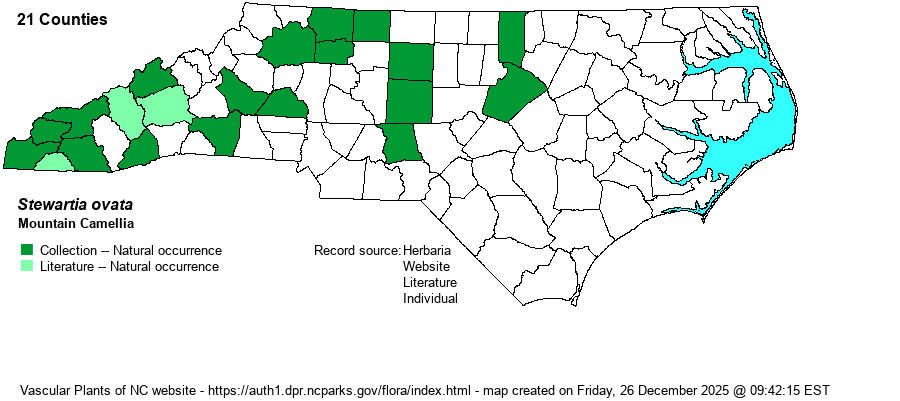| Author | (Cavanilles) Weatherby | |
| Distribution | Widely scattered over the Mountains and Piedmont, east to Granville, Wake, and Montgomery counties. However, within this large range, it is known from only about 20 counties, none of which are in the Mountains north of Madison County. The distribution is centered in the Piedmont foothills and monadnocks region, as well as in the far southwestern Mountains.
This species has a small range centered on the Southern Appalachians. It occurs north to southwestern VA and southeastern KY, and south only to the northern parts of GA and AL, barely into MS; there is a disjunct record in eastern VA. It avoids the higher mountains and is most widespread in the Cumberland Mountains and Plataeu of KY and TN.
| |
| Abundance | Rare to uncommon in the southwestern Mountains, mainly from Macon and Swain counties westward. Also, rare to locally uncommon in the foothills, from the VA line south to the SC line, mostly in the South Mountains. Very rare to rare elsewhere in the southern half of the Mountains and the rest of the Piedmont; seemingly absent in many counties in this range. This is a State Significantly Rare species. | |
| Habitat | This species has habitats that are not uncommon in the state, so its scarcity is due to factors other than general habitat. It prefers moist forested streamsides, slopes and bluffs with evergreen rhododendrons or Mountain Laurel (Kalmia latifolia), and other cool, moist, and shaded places on acidic soils. | |
| Phenology | Blooms from late June to July; fruits in August and September. Thankfully, it flowers more frequently than does Silky Camellia (Stewartia malacodendron). | |
| Identification | This is a beautiful but scarce tall deciduous shrub or small tree, growing mostly to 10-12 feet tall. The branches are not arranged in as layered or horizontal appearance as is Silky Camellia, but the leaves and flowers are rather similar. It has fairly large, alternate, elliptical leaves, usually with a small acuminate tip; the leaves average about 3-4 inches long. The leaves are essentially entire but at close range, when held up to light, you can see the abundance of cilia along the margins, often a clinching mark for the genus. As with the other species, the leaves begin to show purple coloration above by late summer. If you can see buds, flowers, or fruit, the identification is easy, as the scattered flowers are very large, with five white petals spread across about 3 inches wide; the stamens are usually yellow but may occasionally be purple (which may account for scattered reports of Silky Camellia in the Piedmont and mountains). The styles are separate in this camellia species. To look for this species, search very carefully close to streams or the lower parts of ravines and slopes where Rosebay Rhododendron (Rhododendron maximum) or Mountain Laurel form dense stands, and look for deciduous shrubs mixed with them. The species seldom forms patches or stands, and usually you will see only scattered individuals on any given slope or stream segment. | |
| Taxonomic Comments | None, though a few references list two varieties for it.
| |
| Other Common Name(s) | Mountain Stewartia | |
| State Rank | S3 | |
| Global Rank | G4 | |
| State Status | SR-P | |
| US Status | | |
| USACE-agcp | | |
| USACE-emp | | |

